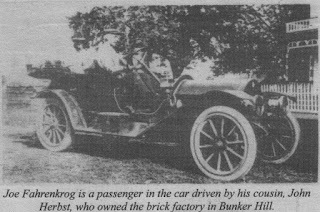Pictured: The present-day Bunker Hill Post Office
What is known as the Bunker Hill Post Office was established in 1833, under the name of Lincoln. It was located on a farm one mile south of town, land later occupied by I. A. Smith in 1885. There is some discrepancy as to who was the first postmaster. An article in the December 3, 1885 issue of the Bunker Hill Gazette names Anthony Linder as the first postmaster. Then Centennial edition of the Gazette names John Wilson or John Lunderman. (See more about the Lincoln Post under blog "True and Tilden's Folly" at https://bunkerhillhistory.blogspot.com/2014/09/true-and-tildens-folly.html )
Pictured: Bunker Hill's first Post Office, Lincoln
In 1837, Lincoln failed to materialize as a town, and the office was moved to Bunker Hill, but retained its former name. Josiah Richards then acted as Postmaster. In the following year, on petition, the name of the post office was changed to Bunker Hill, and Nathaniel Phillips was appointed its first postmaster.
(Excerpt from the 1911 "History of Macoupin County (pg. 360) states "Anthony Linder was succeeded by a Mr. Cook, , while in 1837, Samuel Buell took charge of the office. In November of the latter year, the Post Office was transferred to Bunker Hill. Nathaniel Phillips was the first postmaster appointed after the removal of the office to Bunker Hill. Josiah Richards then acted as assistant. In 1837, a post office was also established in Woodburn")
Mr. Phillips served until his death in 1845, when Judge Philander C. Huggins took charge and removed the office from its location on the lot north of the Congregational Church to his store on the side of George Drew's building on Washington Street.
Pictured: People traveling to Bunker Hill via Stage Coach
In those days, mail was carried by coaches on the St. Louis and Chicago Stage Line. The stage arrivals were very irregular and it was no infrequent occurrence for the postmaster to be gotten out at any hour after midnight to change mail.
Judge Philander C. Huggins held the office about two years when Edward H. Davis succeeded him and removed the business to the "Old Tavern". About a year later, David Wright circulated a petition asking the appointment of Judge Huggins, and the office was moved back into that gentleman's store building.
During the term of office, the Alton and Terre Haute Railroad was built and a better mail service was established. (See "The Big Four Station" blog post at: https://bunkerhillhistory.blogspot.com/2014/10/the-big-four-station.html and "Lee and Arthur Sutton - Railroad Clerks" - https://bunkerhillhistory.blogspot.com/2014/10/lee-and-arthur-sutton-railroad-mail.html )
In 1856, Judge Philander C. Huggins accepted a legislative nomination and resigned his position. He was succeeded by Deacon Noah Flanigan, who held the office until the end of Lincoln's administration.
Pictured: Railroad Mail Clerks, Lee and Arthur Sutton
During the term of office, the Alton and Terre Haute Railroad was built and a better mail service was established. (See "The Big Four Station" blog post at: https://bunkerhillhistory.blogspot.com/2014/10/the-big-four-station.html and "Lee and Arthur Sutton - Railroad Clerks" - https://bunkerhillhistory.blogspot.com/2014/10/lee-and-arthur-sutton-railroad-mail.html )
In 1856, Judge Philander C. Huggins accepted a legislative nomination and resigned his position. He was succeeded by Deacon Noah Flanigan, who held the office until the end of Lincoln's administration.
About the close of the Civil War, Mr. Flanigan was succeeded by E. Atchinson, who served until 1868, followed by Edward H. Davis. As soon as General Grant was elected president, Mr. Atchinson was reinstated in the summer of 1869.
In 1872, Mr. Atchinson resigned and was succeeded by F. Y. Hedley. In November of 1885, T. J. Carroll was appointed. The following is a list of postmasters following Mr. Carroll:
- F. Y. Hedley - September 28, 1889
- J. S. Klinefelter - October 20, 1893
- William P. Dickie - January 20, 1898
- M. M. Brown - February 1913
- J. H. Truesdale - February 1922
- Charles M. Jacobi - June 23, 1932
- Ed A. Bauser - July 1, 1936 (or June 23, 1936*)
- Edna A. Bauser (Acting Postmaster) - March 5, 1940*
- Edna A. Bauser - October 10, 1940* (also see "Bunker Hill's Youngest Postmaster", https://bunkerhillhistory.blogspot.com/2014/09/miss-edna-bauser-youngest-postmaster.html )
- M. L. Kohlenberg (Officer-in-Charge) - August 25, 1972*
- William E. Vaughn, November 25, 1972*
- David A. Wolf (Officer-in-Charge) - May 27, 1994*
- David A. Wolf - June 11, 1994*
- Lisa M. Pierce (Officer-in-Charge) - November 22, 2013*
- Lisa Pierce - April 5, 2014*
...Read more about this and other Bunker Hill, IL historical stories at https://bunkerhillhistory.org/













